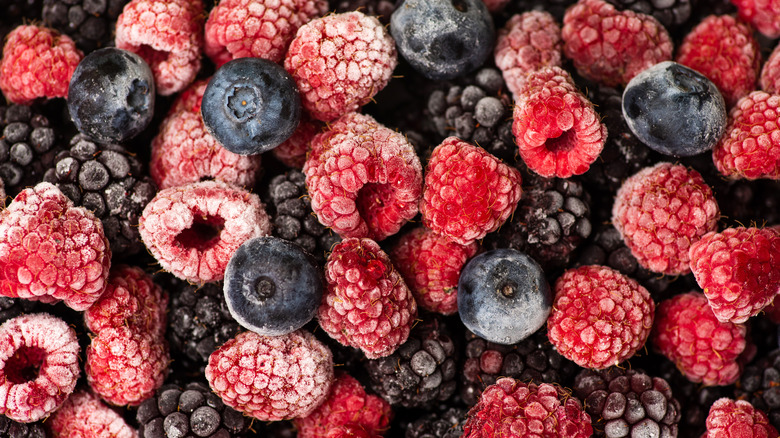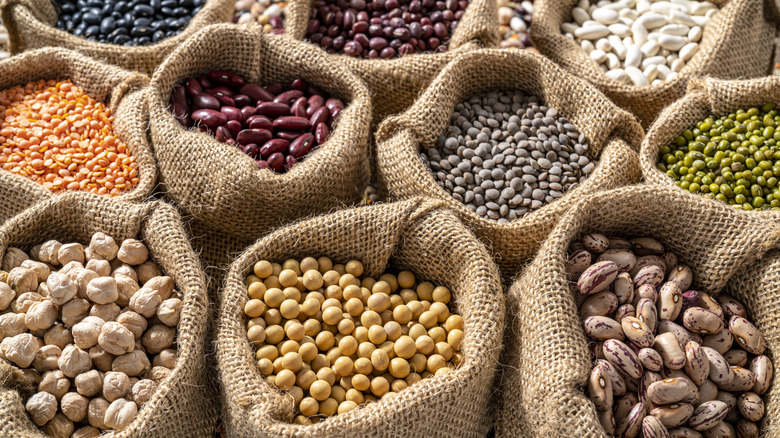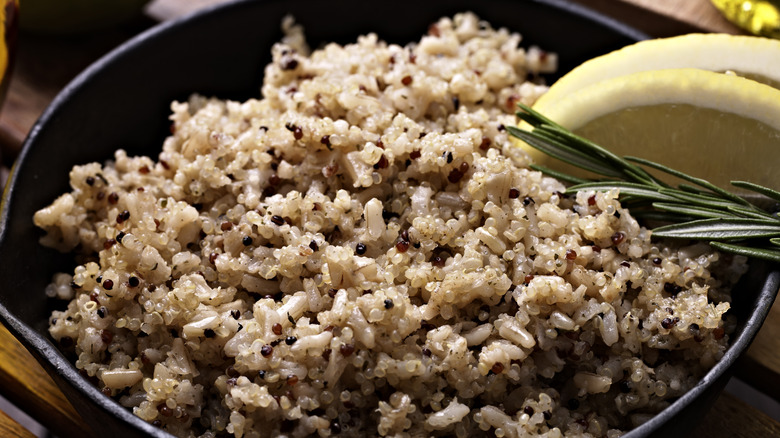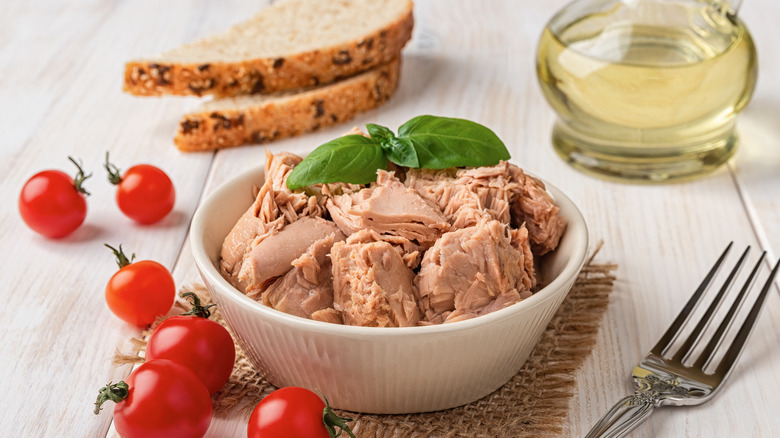14 Processed Foods That Are Actually Good For You
The term "processed foods" has gained a bad reputation, and is often synonymous with sugar-laden cereals, deep-fried snacks, and preservative-packed meals. Yet, the variety of processed foods is broad, with many products undergoing minimal processing that retains the food's nutritional value.
Some examples include frozen fruits and vegetables, canned beans, and pre-cooked rice. Other processed foods, such as yogurt and cereal, can be healthy if you know what to look for and what to avoid. As for dairy and plant-based milks, they undergo processing to ensure safety, extend shelf life, and improve taste and texture. In other words, just because a certain type of food is processed doesn't automatically mean it's bad for you.
There's no doubt that processed foods are often more convenient than fresh foods, and sometimes foods in a bag, box, or can are all you have time for. Keep this list handy so that you know what to reach for on those days you're in a hurry.
Dairy and plant-based milks
Dairy milk is typically pasteurized, which is a heat treatment used to kill harmful bacteria, and homogenized to prevent fat separation (via DrinkMilk.com). Some milks are also fortified with vitamins. Plant-based "milk," derived from sources like almonds, soy, or oats, is processed to extract the liquid, remove impurities, and achieve a milk-like consistency. These milks may also be fortified with vitamins and minerals, often to match the nutritional profile of dairy milk.
Both are good sources of essential nutrients. Milk is high in calcium and protein, which promote strong bones and muscles. The benefits of plant-based milks depend on the plant they come from. Soy milk is a rich source of protein, and milks made from nuts and seeds, such as almond, macadamia, and flax, are good sources of heart-healthy fats (via Harvard T.H. Chan School of Public Health).
To keep your glass of milk healthy, avoid products with added sugars, such as chocolate milk. Plant-based milk often has added sugar to provide a sweeter flavor that matches the natural sugars in dairy milk. It's a good idea to avoid this by looking for unsweetened varieties.
Nuts, seeds, and nut butters
Nuts, seeds, and nut butters typically come in a box, bag, can, or jar — but don't pass them by just because they're not "fresh." Many varieties are nutrient powerhouses that offer a ton of health benefits.
All types of nuts and seeds contain generous amounts of essential vitamins and minerals, as well as protein. The unsaturated fats in nuts and seeds like walnuts and almonds can help lower bad cholesterol, and the omega-3 fats in seeds such as chia and flaxseed have been linked to reduced blood pressure and a decreased risk of heart disease (via Healthline). And, even though they're high in calories, nuts can actually help you maintain your weight when eaten in moderation. Their high fiber and protein content can make you feel fuller for longer, potentially leading to reduced overall calorie consumption. Additionally, their magnesium content and healthy fats play a role in stabilizing blood sugar levels, making them especially beneficial for those with diabetes or insulin resistance.
But — there's always a but — nuts and nut butters can easily become unhealthy when they are mixed with added sugar, or worse, high-fructose corn syrup. Read nut butter labels carefully, and steer clear of anything with added sugar. The best choice is a product with a single ingredient: nuts! When choosing whole nuts, avoid honey-roasted varieties and those with high amounts of sodium, which can increase your blood pressure and your risk of heart disease.
Tofu
Tofu is made by coagulating soy milk, which is extracted from soaked and ground soybeans. The resulting curds are then pressed into solid blocks, forming tofu. Most commercially processed tofu may contain preservatives or other additives to extend shelf life and prevent spoilage. For example, one brand contains less than 2% of calcium sulfate and magnesium chloride, both of which the Environmental Working Group says are safe for human consumption. You may be able to find some brands without preservatives, too.
If preservatives concern you, read the labels on tofu products and consult a list of food preservatives and additives to avoid — but don't shun tofu all together. Soy is an excellent source of plant-based protein, with 10 grams per serving (via the Cleveland Clinic). And tofu is cholesterol-free, which can't be said for animal sources of protein. Tofu contains fats, but they're unsaturated. These types of fats can actually help improve cholesterol and boost heart health. If you're watching your weight, tofu is a great protein option because it's low in calories, with only 100 per serving.
If you're worried that consuming soy increases your risk of breast cancer, don't be. Although isoflavones in tofu are slightly estrogenic, a wealth of research has found no connection. In fact, soy has been found to potentially help lower the risk of certain cancers, including those of the lung and prostate.
Yogurt
Yogurt is produced by fermenting milk using specific bacterial cultures, primarily Lactobacillus bulgaricus and Streptococcus thermophilus (via Harvard T.H. Chan School of Public Health). The fermentation process breaks down the milk's lactose into lactic acid, giving yogurt its characteristic tangy flavor and thick consistency. This processing not only enhances the product's taste and texture but also introduces beneficial probiotics that support digestive health.
Most traditional yogurts are preserved naturally through the fermentation process, where the lactic acid produced by bacterial cultures acts as a natural preservative, inhibiting the growth of harmful bacteria. However, some commercially produced yogurts, especially those with added fruits or flavors, may contain preservatives to extend shelf life or maintain product consistency. Not to mention that sweetened yogurts can contain considerable amounts of added sugar.
As long as you choose unsweetened varieties, yogurt is a healthy option in the dairy aisle. Rich in essential nutrients like calcium, vitamin B, and phosphorus, it supports bone health and can prevent osteoporosis (via Healthline). The live probiotics in yogurt promote a healthy gut, aiding digestion and potentially reducing gastrointestinal disorders like IBS. Yogurt is also packed with protein, which supports muscle growth and satiety. Additionally, its probiotic content may enhance immune function, providing resistance against infections. Some studies suggest that yogurt can help manage weight and reduce the risk of chronic diseases like type 2 diabetes.
Packaged salads and vegetables
Washed, chopped, and ready to eat, packaged salads and vegetables are the busy person's best friend. But, technically, they're a processed food. It's true that they're are some downsides to pre-packaged produce. There's potential for nutrient losses during washing, chopping, and storage, and a slight risk of bacterial contamination, with outbreaks occasionally linked to pre-packaged salads. This risk arises from the multiple handling points and the moisture-rich environment inside sealed bags, which can foster bacterial growth. However, nutrient losses are typically minimal, and if the convenience of pre-packaged produce enables you to eat more of it, then it's a win-win (via CNN).
You can reduce the risk of bacterial contamination by buying greens and other prepackaged produce with expiration dates as far in the future as possible. Put them in the fridge as soon as you get home, and use them up within a few days. If you see any decomposing leaves, don't risk it, and toss out the rest (via The Washington Post). You can also stick to greens and other veggies you can cook, such as spinach and kale, which will kill bacteria. This may be an especially good choice for people who are elderly, immunocompromised, or pregnant.
Frozen fruits and vegetables
Frozen fruits and vegetables sometimes get a bad rap in both the culinary and nutrition worlds. A common misconception is that frozen produce lacks the nutritional value of its fresh counterparts. Some believe freezing might strip away essential vitamins and minerals. In fact, frozen produce is typically harvested at peak ripeness and immediately flash-frozen, a process that often retains, and in some cases surpasses, the nutrient levels compared to fresh produce that's been stored for longer durations (via CNN). This method of preservation not only offers a longer shelf life, reducing food waste, but it also ensures that you always have nutritious ingredients in your kitchen. And of course, the pre-washed and pre-cut state of frozen produce cuts down on preparation time. Another benefit is year-round availability — peaches in December, for example. Additionally, the freezing process can inhibit harmful bacterial and fungal growth, rendering these products safer in some instances.
Frozen fruits are perfect for smoothies, as they take the place of ice. They can also be baked into muffins or pies, or simply thawed for use in salads and desserts. Frozen vegetables can be directly steamed or sautéed for a quick side dish, or incorporated into casseroles, soups, and stir-fries. Their convenient and pre-prepped nature also makes them ideal for quick omelets, grain bowls, and pasta dishes.
Canned beans
It's true that many canned foods aren't good for you. Highly processed, fatty and salty soups and stews and fruit in sugar syrup contain little nutrition and a lot of additives that shouldn't be part of a healthy diet. Although rare, some manufacturers may still use canned food linings containing bisphenol A (BPA). However, don't skip the canned foods aisle altogether; some healthy options reside there if you know how to find them. A rich source of protein, fiber, and essential nutrients, canned beans are a convenient option offering the same health benefits as dried beans. As far as protein sources go, they are very inexpensive compared with animal foods and, in many cases, are better for you because they're free of saturated fat and cholesterol. The protein and fiber in beans promote satiety and digestive health, and they're also excellent sources of iron, magnesium, and potassium (via NutritionFacts.org).
Sodium is the biggest problem with canned beans, with some varieties containing many times the amount in dried beans. A high-sodium diet can elevate blood pressure, increasing the risk of heart disease and stroke. When selecting canned beans, opt for those labeled "low-sodium" or "no salt added" to manage sodium intake. If you can't find no or low-sodium options, you can rinse the beans before eating them to get rid of some of the salt. Additionally, check the label and ingredients list to make sure there are no unnecessary additives or preservatives and that the can is BPA-free.
Pre-cooked brown rice
Pre-cooked rice is parboiled, packaged, and ready to eat in minutes. While convenient, it's not always healthy, especially if it's white rice. Pre-cooked or not, white rice is highly processed and stripped of fiber and nutrients. It's also a high-glycemic food, which can cause rapid fluctuations in blood sugar that affect your energy levels and cause sleepiness, moodiness, and food cravings, among other things. In fact, higher consumption of white rice is linked with a higher risk of developing type 2 diabetes (via CNN).
Brown rice is less processed and healthier for you. It retains its nutrient-rich bran and germ layers, offering higher levels of fiber, vitamins, and minerals compared to white rice. Brown rice also has a lower glycemic index, leading to more stable blood sugar levels after consumption. Pre-cooked brown rice offers the convenience of quick preparation without significantly compromising its nutritional benefits.
One potential problem with pre-cooked rice (even brown rice) is preparations containing high amounts of sodium or other unhealthy additives. So it's essential to check product labels. When chosen wisely, pre-cooked brown rice topped with lean protein and veggies is a healthy and time-saving option for busy weekday meals.
Bean pastas
Pasta is a moderately processed food. It's made by mixing milled grains, usually durum wheat, with water to form a dough. This dough is then extruded or rolled into various shapes and dried to create the finished product. White pasta gets an especially bad rap as a refined carbohydrate, which can lead to quick spikes in blood sugar and contribute to weight gain when consumed in excess.
Bean pastas, made primarily from legume flours, are gaining popularity due to their higher protein and fiber content compared to traditional wheat pastas (via the Cleveland Clinic). They're a gluten-free and more nutrient-dense option, providing both sustained energy and added health benefits. Some people don't like the texture of bean pastas. Wheat pasta typically has a smooth texture and offers an al dente bite when cooked properly. Bean pasta, on the other hand, often has a slightly denser and grainier texture, sometimes leaning towards a softer or mushier consistency when compared to traditional wheat pasta. But others like this texture and like the fact that, even as a processed food, bean pasta offers considerably greater nutritional benefits than traditional pastas. If you love pasta but also want to stay healthy and maintain your weight, bean pasta is a great way to have your cake (or pasta) and eat it too.
Canned fish
The American Heart Association recommends that adults consume at least two servings of fish per week. Fish is a rich source of omega-3 fatty acids, which are essential for heart and brain health, reducing inflammation, and supporting overall well-being. Additionally, fish provides high-quality protein, vital for muscle maintenance and growth, alongside essential vitamins and minerals like vitamin D and selenium. Consuming fish regularly has been linked to a decreased risk of chronic diseases and may contribute to improved cognitive function (via LCMC Health).
But shopping for and preparing fresh fish regularly takes time and advanced planning, which are in short supply for most people. So you might wonder if you can get the same benefits from canned fish, which is already cooked and ready to go. The answer is... in many cases, yes. Many canned fish options, like salmon, sardines, and tuna, retain much of their nutritional value, including omega-3 fatty acids (via the USDA). And canned fish with soft bones, such as sardines and salmon, are an excellent source of calcium.
The main problem with canned fish is the added sodium, which can be detrimental to heart health. Some fish is also canned in oil or other high-calorie sauces, so it's important to read labels and look for low-sodium options canned in water. If mercury is a concern, choosing varieties like chunky light tuna, salmon, and sardines can be beneficial.
Some frozen meals
If you resort to frozen meals more often than you'd like, you're not alone. Statistics show that millions of Americans eat them, and that number is on the rise (via Statista). Unfortunately, many frozen meals contain high levels of sodium, preservatives, and unhealthy fats, which can contribute to health issues like hypertension and heart disease. Additionally, they often lack sufficient nutrients, relying heavily on refined carbohydrates and offering minimal whole-food ingredients.
But there are some healthy options out there if you know what to look for. When selecting healthy frozen meals, choose options with whole-food ingredients and a balance of protein, fiber-rich carbohydrates, and healthy fats. Ensure the sodium content is less than 600 milligrams, and avoid meals with excessive added sugars or artificial preservatives. Checking the ingredient list for recognizable ingredients and prioritizing those with more vegetables can also guide healthier choices (via the Cleveland Clinic).
Low-sugar cereal
You'd probably be surprised at just how bad some cereals are for you. Many are loaded with added sugars, which can contribute to weight gain, dental problems, and increased risk of chronic diseases. Low fiber and protein contents result in minimal satiety, which means you'll be hungry soon after breakfast. But if you love cereal and its convenience, it's not all bad news. There are some healthy options out there.
Choosing a healthy cereal requires careful scrutiny of the labels. Start by checking the sugar content; a healthy option should ideally have less than 9 grams of sugar per serving (via the Cleveland Clinic). Look for cereals that list whole grains like oats or whole wheat as their primary ingredient, as they are nutritionally superior to refined grains. A good rule of thumb is to opt for cereals with at least 3 grams of fiber and 5 grams of protein per serving to promote healthy digestion and prolonged feelings of fullness. Be cautious of cereals with long ingredient lists, as these often indicate the presence of unnecessary additives and preservatives. While flashy marketing terms such as "natural" might seem appealing, they can be misleading; always base your choices on the nutrition label and ingredient list for a clearer understanding.
Hummus
Plastic containers of hummus are regular offerings in the pre-packaged and prepared foods section of many grocery stores. Does that mean you shouldn't eat them? Quite the contrary. Hummus is primarily made from mashed chickpeas blended with tahini, lemon juice, garlic, and olive oil, all of which are nutritious ingredients that contribute to good health. Hummus is rich in protein, fiber, and healthy fats, contributing to satiety and aiding in digestive and heart health. Its ingredients, particularly chickpeas and tahini, also provide essential nutrients like iron, folate, and antioxidants. The foods eaten with hummus are typically healthy as well. It's traditionally served with flatbreads like pita or lavash and is also a popular dip for fresh vegetables such as carrots, bell peppers, and cucumbers. Additionally, it can be used as a spread in sandwiches and wraps.
However, while hummus contains nutritious ingredients, store-bought versions can sometimes contain excessive salt or unhealthy additives and preservatives. They're also calorie-dense and easy to overconsume, which, despite the food's health benefits, can contribute to weight gain. Read labels, and select varieties with wholesome ingredients, and consume hummus in moderation.
Dark chocolate
Most items in the candy aisle aren't good for you and shouldn't be a part of your regular diet. Excessive sugar intake can lead to weight gain, metabolic disorders, and an increased risk of chronic diseases such as diabetes and heart disease (via the American Heart Association). However, there's one exception: dark chocolate.
Dark chocolate, especially varieties with high cocoa content, is rich in antioxidants, including flavonoids, which can help combat oxidative stress. Consuming moderate amounts has been linked to improved heart health, including increased blood flow and reduced blood pressure. Additionally, dark chocolate contains compounds that may boost mood and support brain health (via the Cleveland Clinic).
White and milk chocolates typically contain higher amounts of added sugars and fats, offering fewer health benefits than dark chocolate and potentially contributing to weight gain and weight-related health issues. For the healthiest dark chocolate, opt for varieties with a high cocoa content (70% or higher), as they contain more antioxidants and less sugar. Additionally, scan the ingredient list for additives and avoid those with unnecessary fillers, candy coating or pieces, or excessive sugar content. Also keep in mind the recommended serving size, which is 1 to 2 ounces.















